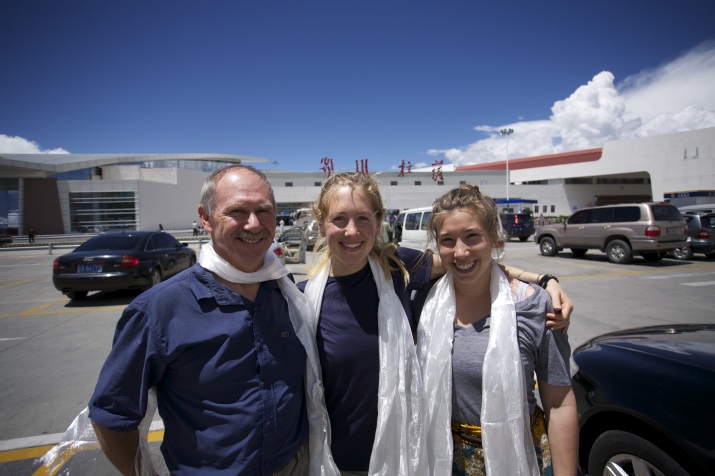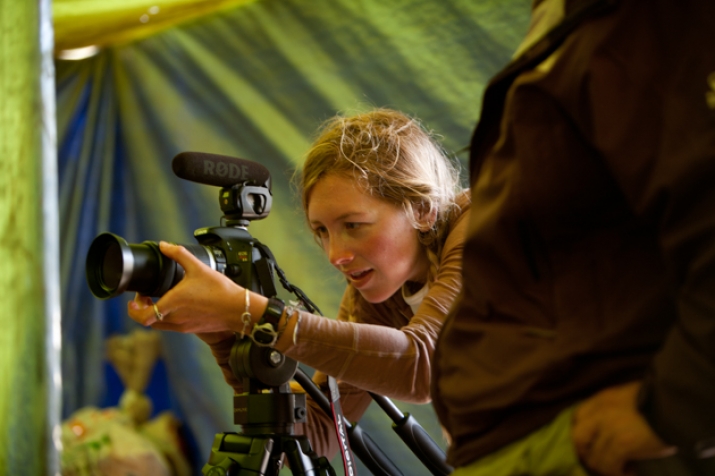FEATURES|THEMES|Film
Nine-Story Mountain Film Crew Interview: Journalism, Pilgrimage, and Preservation
Buddhistdoor Global | 2014-05-07 |
 The Nine-Story Mountain filming crew landing in Tibet, on Day 5 of the expedition. From left: Don Nelson, Augusta Thomson, and Lara Yeo.
The Nine-Story Mountain filming crew landing in Tibet, on Day 5 of the expedition. From left: Don Nelson, Augusta Thomson, and Lara Yeo.Pilgrimage is not technically done for personal enjoyment. The fun comes as a corollary to rigor (few to no holy sites are located in comfortable or lush locations), the difficulties of travel, and sometimes even physical danger (pilgrimage always implies an ascetic dimension). These struggles are offered to a higher presence, through simultaneous immersion in awe and gratitude.
When the film crew of Nine-Story Mountain got in touch with me, I was fortunate to be invited to review the film first. Watching the movie beforehand helped me to understand that the crew’s struggles, while individually unique, were reflections of a universal impulse. According to Don Nelson, the expedition photographer, his arrival at the mountain unveiled “the simply stunning” faces of Mount Kailash. This perspective gave him “immense physical relief”, providing “fantastic opportunities for great photos.” Nelson was especially captivated by the “lighting as night approached and fell on the snows of the huge north face,“ a natural effect which connected him spiritually to “the very core of the mountain.”
Still, a holy site would be nothing without devotees to nourish it with worship. While taking expedition photographs, Nelson always tried to find a bond with the pilgrims he photographed. That commitment to capturing a momentary human encounter reflected Nelson’s many years of leading treks along the Kailash pilgrimage track. During the journey he “tried to look for a quick glimpse” of each pilgrim’s “unshakeable spirit.” The eyes were where he felt that connection was most visible. Nelson felt lucky when he managed to capture some aspect of that eye-to-spirit connection.
Nelson has led pilgrimages to Mount Kailash since 1999. Yet this trip was distinct. As far as he was concerned, it was his fellow travellers who provided a sense of true purpose, as they tried to arrive at a deeper understanding of the Mount Kailash pilgrimage. “The leadership and driving force that Augusta [the film's director] managed to find as our leader in that harsh environment and over that long period of time was simply awe-inspiring.”
Action through Living Narrative
Lara Yeo was in the first semester of her human rights and humanitarian action Masters when the film’s director, Augusta Thomson, approached her with the offer to join the expedition to Mount Kailash. “I immediately committed to the trip, recognizing the unique opportunity,” she said. “While undertaking an anthropological research expedition might seem outside my realm of academic and professional interest, one of my undergraduate academic advisors was a feminist ethnographer, and I have longstanding interests in pilgrimage and Tibetan Buddhism.”
According to Yeo, “Human life is made up of stories. Fantastical, brutally crushing, inspiring, debilitating – stories contribute to how we perceive and live in the world.” She realized that she had lost site of the power of narrative during her immersion in academia – “both undergrad and grad school.” Lara’s “submersion in empirical studies, conducting quantitative analysis” led her to value a specific type of story – one anchored in “detached reading of scholarly articles and studies.” The trip with Thomson and Nelson prompted her to rethink the full significance of stories. She fondly recalled Augusta's own love for stories: “She thrives on them, wholly embraces them. She believes in them fully… But what I have come to appreciate through the expedition and through our work on Nine-Story Mountain, is that we’re sharing the stories. In doing so, we are sharing a part of Kailash that we came to know, the Kailash that is alive for us.”
One of Yeo’s most fulfilling experiences came during her third circumambulation around Kailash, a day trek from Driraphuk up over Drolma La pass. As the team took down camp and started out at 6:30am in the bitter cold she experienced a searing altitude headache. Yeo explained that, instead of “relaxing into the pain, syncing my breathing with my pace, resting when I needed, and embracing my slower pace, I became overly bothered and then downright distressed, when Augusta was easily ambling on in front of me. I wanted to be able to move just as fast as her and could not let go of this want.” Yeo was forced to let go of her physical condition, even though it had fouled her temper. As she examined her inner thoughts, a young girl ambled up to her and started to walk beside her. Yeo was touched by the young girl’s recognition: “She could have easily walked at twice my pace … but she didn't. She walked with me and she took breaks with me. She couldn't speak English and I can't speak Tibetan, so we only communicated through smiles and pats on each other's arms. A language of gestures.”
 Augusta Thomson. From Nine-Story Mountain.
Augusta Thomson. From Nine-Story Mountain.Journalism that serves Buddhism and Activism
This pilgrimage has united the film team’s affective experiences with their own professional goals. Thomson advocates deploying journalistic techniques and methodologies to raise issues of culturally sensitive conservation strategies. She observes that journalism is in the middle of a huge transformation as it becomes increasingly digitalized. More people have the opportunity to work, even if informally, as journalists. Personal blogs and social media are empowering and could serve as advocates for conservation and spirituality.
Thomson suggests that “using an anthropological lens, via film and text, to understand journalistic stories could be hugely influential. It could empower people around the world to speak for themselves. Anthropologists are known for their skill in doing in-depth research. That anthropological perspective is increasingly valuable in a world where so many people attach meaning to people and places without really knowing the full picture. In the future I hope to knit my passion for journalism with anthropology by making films about marginalized communities, that not only spread awareness about lesser-known stories, but inspire those communities to take a critical interest in film and media.”
Who Owns the Mountain?
Cultural preservation, particularly when done by external parties, is always a tenuous issue. Issues of ownership and proper protocol are entangled with sustainability and inclusivity, which involves local as well as international partners. “Because I believe that the ultimate aim of journalism should be to convey perspectives and stories with honesty, I feel like there is a lot of value in telling the lesser-known stories behind preservation. I am also of the mind that everything should be preserved, because every story arc is informed by the stories that came before.” Thomson realized early on that one journalistic approach to preserving the mountain would be to actually turn her film into a cultural protection project, rather than simply launching a campaign for conservation.
“Little is known about the environmental significance of Kailash and its influence on water supplies to the surrounding region,” says Thomson. “Allowing an expedition of scientists to visit the mountain to measure the waste build-up and landscape degradation could help people to become more aware of the repercussions of increased construction projects like roads and guesthouses and waste accumulation.” That said, she emphasizes that any scientific research would have to be done carefully and sensitively, to honor the spiritual and historical legacy of the mountain. The team has started a campaign to push the ICOMOS International Committee on Twentieth Century Heritage to issue a heritage alert for Kailash. Thomson believes that “preservation at Kailash will take off if it is officially recognized by the Chinese government, and the government is willing to work with Tibetan, Hindu, Bon, and Jain pilgrims, in addition to other believers, to ensure that their reverence for the mountain is honored.”
Thomson is honest about the vital role of China’s government. “The only way official movements to preserve Kailash will hold any weight is if the Chinese government supports them.” The site also needs to be nominated as a World Heritage Site. World Heritage sites gain an automatic status that invites more attentive preservation. “One of those ways is to pressure the ICOMOS to issue a heritage alert to pressure the Chinese government to officially nominate Kailash. As lobbying is done internally, China will have to step forward as a leading force in this nomination.”
Thomson also believes that pilgrims and tourists need to be made more aware of the repercussions of leaving garbage along the route. She suggests building a culturally mindful center that will employ locals at the base of the mountain. The center could teach people about recycling and proper waste management, and to work with pilgrims to establish a sense of “pilgrim ethics”: at the end of the day, pilgrims are still guests in a holy space. It seems only fair that guests appreciate the need for protocol.
Homecoming
After Mount Kailash, Yeo has returned to everyday life with a renewed perspective on her own work as an advocate for women’s rights. “My experiences with pilgrimage have been very powerful and inform how I think about my work in my field as well as the way I live my life in general. In pilgrimage, one’s thinking can be hugely expansive as it looks to the journey’s end goal and the horizon of the eternal. Or it can be very narrow, when you’re immersed completely in the present. I approach my work, and the myriad aspects of my life, in the same way. I have my ideas of the 'end goal' – where I want to be in my life at certain stages – but I distance myself from this more expansive view to instead focus on the day-to-day, accepting that there is so much unknown.”
She emphasizes that “being ready to celebrate the bumps and accept that much can change between the interim of now and the end goal” has hugely informed how she approaches her work “because women's rights campaigning and advocacy is a long-term game.” Yeo notes that, “in the case where campaigns are on-going, to contribute in a meaningful, positive way, year after year, one needs to be cognizant of and committed to the 'end goal,' yet ready for the twists and turns of the present.” In some ways, the blisters, tendonitis, and bad weather that Yeo experienced on pilgrimage reflect the lobbying, policy reports and legal cases that one encounters in human rights campaigning. “You need a calm, centered sort of patience, and an impassioned, determination to carry on, to keep on walking forward.”
Any journey to a pilgrimage site is inconclusive. The realizations one has during and after the journey carry on indefinitely, informing and educating as new realizations begin to percolate and blossom. In the end, regardless of how one absorbs the lessons of Mount Kailash in work or life, its moral, ethical, and spiritual power continues to move the pilgrim long after the journey and the fond memories that follow.
See more about the film on Buddhistdoor

Comments:
Share your thoughts:













